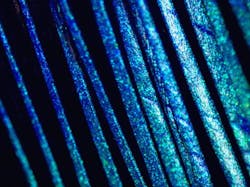Naturally occurring crystals could hold key for renewable energy
The discovery of a complex, 3D crystal within a leafbird’s feathers could mean more efficient fiber optics, solar cells, and more. This is promising in the increasing search for renewable sources of energy and sustainable manufacturing.
Led by Dr. Vinod Kumar Saranathan, a senior research fellow in the Division of Science at Yale-NUS College in Singapore and an assistant professor in the Department of Biological Sciences at the National University of Singapore, an international team of researchers—from Argonne National Laboratory (Argonne, IL), ETH Zurich (Zurich, Switzerland), and Yale University (New Haven, CT)—made the finding while studying feather colors of leafbirds (perching birds that are widespread in Singapore, as well as throughout Southeast Asia).1 Called a single gyroid, the 3D photonic crystals are embedded within the feathers of specifically the blue-winged leafbird.
In their study, the researchers compared the color-producing nanostructures that exist in the blue-winged leafbird’s close relatives (see figure). They found that this particular species can directly synthesize the single gyroid photonic crystals—the optical properties that exist make them ideal for use in technology including photovoltaic cells for applications including solar energy generation.
Overcoming limitations
According to the team, industrial manufacturing of small single gyroid photonic crystals for use in the visible light spectrum, “via self-assembly, a process that spontaneously brings together nanoscale chemical 'Lego blocks,'” is extremely difficult. Larger crystals can be manufactured and subsequently heat-shrunk to work with visible light, but this can often produce defects and can only be done on a small scale.
“The way leafbirds manufacture these crystals is much more straightforward than how butterflies—some of which use the same structure in their wing scales—or material scientists are known to do," Saranathan says.
Beyond this, the researchers are gaining insight into the “class of patchy particles” such as charged proteins for future investigation, “to see if they can be coaxed into forming these crystals at visible-light scales.”
“Knowing how leafbirds manufacture these exotic structures can spur novel biomimetic eco-friendly self-assembly strategies for large-scale materials synthesis at these highly challenging optical length-scales,” Saranathan says, noting an urgent ecological need for such materials in the search for renewable sources of energy and sustainable manufacturing.
Single gyroid photonic crystals show great potential in fiber optics and other industrial applications, as well as in photovoltaic components such as solar and fuel cells.
REFERENCE
1. V. Saranathan, S. Narayanan, A. Sandy, E. R. Dufresne, and R. O. Prum, Proc. Nat. Acad. Sci., 118, 23, e2101357118 (Jun. 8, 2021).
About the Author
Justine Murphy
Multimedia Director, Digital Infrastructure
Justine Murphy is the multimedia director for Endeavor Business Media's Digital Infrastructure Group. She is a multiple award-winning writer and editor with more 20 years of experience in newspaper publishing as well as public relations, marketing, and communications. For nearly 10 years, she has covered all facets of the optics and photonics industry as an editor, writer, web news anchor, and podcast host for an internationally reaching magazine publishing company. Her work has earned accolades from the New England Press Association as well as the SIIA/Jesse H. Neal Awards. She received a B.A. from the Massachusetts College of Liberal Arts.

